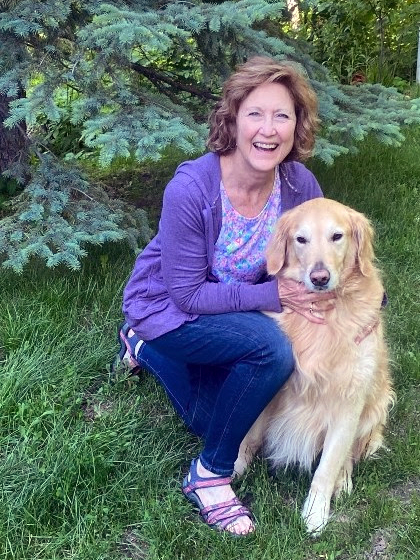Bill Nye once said, “Everyone you will ever meet knows something you don’t.” AIS Detectors program volunteer Cindy Gackle embodies that spirit, taking full advantage of making connections, gaining experiences and learning new things.
The North Dakota native ventured to Minnesota in pursuit of a career in occupational therapy. Now retired, Cindy, her husband Randy, and their golden retriever Murphy are still Minnesotans, splitting their time between northern Minnesota and what she jokingly referred to as “down south” near the Twin Cities.
Working in the healthcare field, Cindy never expected she would one day be studying the life cycles and effects of invasive plants and animals that could potentially inhabit her favorite lakes. Her journey began with a personal connection to the Wabedo-Little Boy-Cooper-Rice (WLBCR) Lake Association Board thanks to her husband being a board member. After joining the board herself, the need arose for an aquatic invasive species (AIS) committee chair and it was an easy decision for her to jump in.
While grappling with the unfamiliar terminology and processes in her new role, Cindy met someone at an Association of Cass County Lakes (ACCL) meeting who introduced her to the AIS Detectors program. Initially, Cindy believed she couldn’t possibly fit any more learning into her life. “I thought, ‘Oh, there's just too much new learning going on already. I can't even think about one more thing.’” But it turned into a great resource for her favorite pastime: networking.
Through her connections, she was able to sit in on a DNR review meeting. “A lot of stuff [went] over my head, but yet it was a way of meeting people and then connecting with them over time. So I guess one of the favorite parts of volunteering has to do with the networking and the learning and the new relationships that have evolved from it.”
Connections have paved the way to sourcing and creating cost-effective AIS tool stations for water accesses. The committee has gotten permission to survey for AIS via rake toss at a local resort and put signage out at a few others. Cindy and the team have also forged a relationship with the local YMCA camp to provide educational, hands-on experiences to their campers. And the WLBCR Lake Association started sending out welcome packets to new property owners in the neighborhood containing educational handouts, decontamination station information, reference materials, and lake association information.
Cindy is a perfect example of how you don’t have to already know everything or dedicate all your time to a cause — as long as you are committed, you can still make an impact. With hobbies such as hiking with Murphy, fishing, painting, stained glass and snowshoeing, Cindy prioritizes balance with her time volunteering. But she was pleasantly surprised at how easily she met the requirements to stay an active AIS Detectors volunteer through her work with WLBCR.
She is also quick to acknowledge the team she is on. “The work we as the AIS committee/team are doing here at WLBCR is a team effort. I’m so very grateful that I have the privilege of working with others who share the same goal of preserving our natural resources. And that together our brainstorming has guided us to some meaningful projects.”
When asked what she would say to someone thinking about taking the AIS Detectors Core Course and becoming a volunteer, Cindy was quick to respond, “[The AIS Detectors team does] a really nice job of trying to reach out to create a community and even if we're not together in person, there's just something personal about it.”
Thanks, Cindy, for being part of our community and making life at the lake better for everyone.


